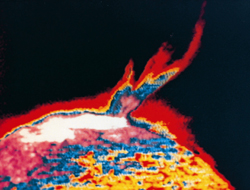Data analysis for solar flares
The radiation produced by solar flares can have significant effects here on Earth, and include causing major disruptions to communication systems. By using hard X-rays, astrophysicists can observe the acceleration and transport of highly energetic particles in solar flares. These observations generate massive amounts of data. Funded by the Space sub-programme of the Seventh Framework Programme (FP7), the 'High energy solar physics data in Europe' (HESPE) is seeking to mainstream this information and make it available to researchers across the EU. Project members are developing and implementing state-of-the-art computational methods to enable scientists to analyse data on solar flares, facilitating original and challenging solar, helio and space science. HESPE's computational corpus contains numerical algorithms for spectral fitting and inversion, image reconstruction, edge detection, image segmentation and more. The system also encompasses optimised data products that are interoperable with standard data analysis software. As the project nears its completion, partners are focusing their efforts on the synthesis of simulated visibilities recorded by the Spectrometer/Telescope for Imaging X-rays (STIX). HESPE will provide scientists with a general paradigm for the selection and classification of solar flares, as well as for the creation of realistic computer models and simulations, among other field-related developments.






